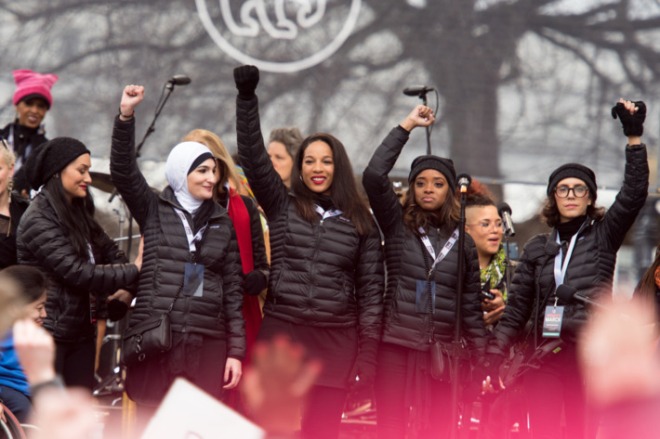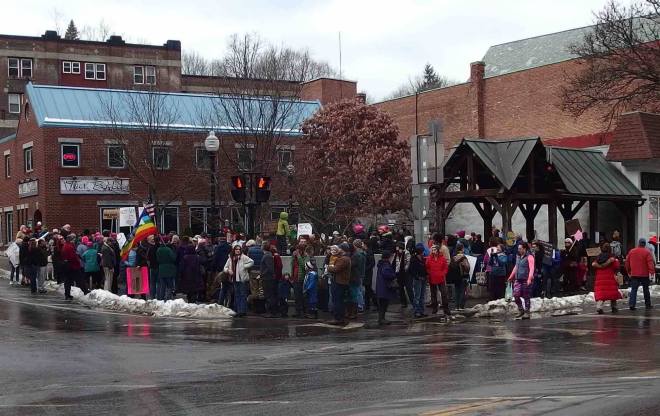A lot of people predicted that women were going to change America’s political history in January of 2017. But pretty much no one anticipated that they’d be doing it as leaders of the resistance. On Saturday, millions of women and men — organized largely by young women of color — staged the largest one-day demonstration in political history, a show of international solidarity that let the world know that women will be heading up the opposition to Donald Trump and the white patriarchal order he represents. Women — and again, especially women of color, always progressivism’s most reliable and least recognized warriors, the women who did the most to stop the rise of Trump — were the ones taking progressive politics into the future.
So begins the best article I’ve seen yet on the Women’s March: The Future of the Left is Female. Written by Rebecca Traister for NYMag.com it is a shrewd analysis of the march, the organizers, and, of the future. It is fairly long, but I encourage people to read the entire thing because my quotations and comments can’t come close to doing it justice.

National co-chairs of the march Carmen Perez, Linda Sarsour, and Tamika D. Mallory at the Women’s March in Washington, D.C.
Plenty of factors made this effort so successful, but perhaps the biggest was the shock and horror that jolted portions of a long-complacent population awake after the election of Donald Trump. As it turns out, sometimes, It Takes a Villain. We’ve got one now; he lives in the White House, has the nuclear codes, and spent Saturday defending the size of his, er, inauguration crowds. In his first weeks in office, he might very well nominate an anti-choice Supreme Court nominee, begin deportations, repeal health-care reform, start the process of withdrawing from the Paris climate accord, and defund Planned Parenthood. He has already reinstated the Global Gag Rule.
I’ve been asked many times “But why didn’t you vote?” Traister’s response
Clearly, the vast majority of Saturday’s crowd had been Hillary Clinton supporters, at the very least in the general election if not in the primary. But it is also true that some of the apathy, some of the complacency, that many critics took as a reflection of Clinton’s “flawed” candidacy stemmed instead from the sense that Americans didn’t really need to panic or take to the streets on her behalf because she was going to win. She was going to win, the assumption went, because of course we are evolved enough that this guy could never get elected president and thus we were free to focus on the imperfections of the woman who was going to be the president.
I admit that I was not an enthusiastic Clinton supporter and spent my energy on local races including Sue Minter who ran for, and lost, the race for Vermont governor. But I voted and voted for Clinton and was among the many who were stunned at the outcome of the Presidential election. The question now becomes where to go from here.
But there was a new metaphysical approach at work on Saturday, largely thanks to the organizing and leadership of nonwhite women: the revolutionary sense that the new women’s movement will be about pulling in issues of criminal justice, environmental activism, immigration reform, and systemic racism. Women, with women of color at front and center, can be the engines of new progressive activism in all arenas. It’s a rebuke to the theory floated by some on the left that there is a disjunction between “identity politics” and politics, a rebuke to those who suggested in the wake of Trump’s electoral win that the future lies in moving away from divisive “social issues” and identity-framed movements and back to economic policies.
What this event did, on the most massive scale we have seen in this country, is reaffirm what has always been true: The impact of identity bias has always been economic, and economic issues have always most powerfully disadvantaged those who experience identity bias. Or to put it another way: Women’s rights are human rights.
That sentence: “The impact of identity bias has always been economic, and economic issues have always most powerfully disadvantaged those who experience identity bias” was at the heart, I think, of Bernie Sanders campaign. Bernie, however, was – let’s be honest – an old white man – and while he began to frame the issue, he could not organize people of color and women who wanted desperately to elect a woman President.
The oil pipelines, the Flint water crisis, pay inequity, low minimum wages, the lack of adequate child care, etc., etc. are in the end economic issues and, they impact women disproportionately.
We can take hope from who marched.
If there was an over-representation of “nice white ladies” marching, it’s important to note that those white women were showing up for a march led by nonwhite women, in support of a radical and intersectional set of policy principles laid out by nonwhite women, carrying signs and marching in solidarity with plenty of women’s issues that do not center on white women. No, we shouldn’t give them too much credit for showing up where they should have been for years. And yes, the next steps must include white women (and men) showing up for women of color in other ways, at other demonstrations and with other actions (including not voting with an eye to their own privilege).
…
Perhaps most surprising of all, men showed up alongside the women to fight for those rights. Many reports had the New York march at about half men, though some of that could perhaps be explained by the number of New York women who went to Washington alone, leaving kids behind with male partners. But those men — including my husband, including my male friends — brought those kids, girls and boys, to the march for women’s rights in New York. Men were at all the demonstrations in great numbers.
I’ve been in the women’s movement for a long time, so long that I was a delegate from Virginia to the First Women’s Conference in Houston in 1977. I look at the poster hanging in my study every day. I have watched the movement come together, fracture over what issues are important, fracture over race, and come together again. The January 21 marches are the beginning of another start. This time WILL be different, I can feel it.
But even if the necessary power realignment within feminism takes time, this historic event will have been a tremendous step toward the reimagining of a women’s movement as a web of varied but interconnected interests and missions.
And as it happens, when it happens, women will be leading the way into the progressive future. Women will lead the revolution.
Photograph: Noam Galai/WireImage

